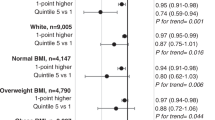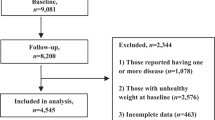Abstract
Introduction:
The promotion of Mediterranean Diets has generated some doubts, because of the concern that its high fat content might lead to the development of obesity.
Methods:
Longitudinal analysis of 6319 participants in the SUN cohort study. We used a validated semiquantitative food frequency questionnaire (136 items). Baseline adherence to a Mediterranean dietary pattern (MDP) was assessed using a score (score_1) including vegetables, fruits, cereals, nuts, pulses, fish, olive oil and moderate consumption of red wine (positively weighted), whereas meat and dairy products were negatively weighted. We assessed the association between the overall baseline adherence to the MDP (score_1) and subsequent weight change after 28 months of follow-up. We also built another score (score_2) to assess changes in diet during follow-up and appraised the association between the joint exposure to both scores and weight change during follow-up.
Results:
Participants in the first quartile of score_1 (lowest baseline adherence to MDP) showed a higher weight gain (+0.73 kg) than those in the top quartile (+0.45 kg). The results indicated an inverse dose–response relationship (P for trend=0.016). A similar inverse association was apparent when we used change in adherence to the MDP (score_2). However, both inverse associations did not remain statistically significant after adjusting for relevant confounders. Consumption of dairy products was inversely associated with weight gain.
Conclusions:
Although participants increased their average weight during the follow-up period, weight increments were smaller among those with a higher adherence to an ‘a priori’ defined MDP. Results did not remain statistically significant after multivariate adjustment.
This is a preview of subscription content, access via your institution
Access options
Subscribe to this journal
Receive 12 print issues and online access
$259.00 per year
only $21.58 per issue
Buy this article
- Purchase on Springer Link
- Instant access to full article PDF
Prices may be subject to local taxes which are calculated during checkout
Similar content being viewed by others
References
Kopelman PG . Obesity as a medical problem. Nature 2000; 404: 635–643.
York DA, Rössner S, Caterson I, Chen CM, James WP, Kumanyika S et al. AHA Conference preceedings. Prevention Conference VII. Obesity, a worlwide epidemia related to heart disease and stroke. Group I: Worlwide demographics of obesity. Circulation 2004; 110: e463–e470.
Trichopoulou A, Costacou T, Bamia C, Trichopoulos D . Adherence to a Mediterranean diet and survival in a Greek population. N Engl J Med 2003; 348: 2599–2608.
Martínez-González MA, Fernández-Jarne E, Serrano-Martínez M, Marti A, Martinez JA, Martín-Moreno JM . Mediterranean diet and reduction in the risk of a first acute myocardial infarction: an operational healthy dietary score. Eur J Nutr 2002; 41: 153–160.
Willett WC . Eat, Drink, and be Healthy. Simon & Schuster Source: New York, 2001.
Bosetti C, Gallus S, Trichopoulou A, Talamini R, Franceschi S, Negri E et al. Influence of the Mediterranean Diet on the risk of cancers of the upper aerodigestive tract. Cancer Epidemiol Biomarkers Prev 2003; 12: 1091–1094.
Martínez-González MA, Sánchez-Villegas A, De Irala J, Marti A, Martínez JA . Mediterranean diet and stroke: objectives and design of the SUN project. Nutr Neurosci 2002; 5: 65–73.
Martín-Moreno JM, Boyle P, Gorgojo L, Maisonneuve P, Fernández-Rodríguez JC, Salvini S et al. Development and validation of a food frequency questionnaire in Spain. Int J Epidemiol 1993; 22: 512–519.
Mataix J . Tabla de Composición de Alimentos, 4th edn. Universidad de Granada: Granada, 2003.
Moreiras O . Tablas De Composición De Alimentos, 7th edn. Madrid: Ediciones Pirámide: Madrid, 2003.
Willett WC, Stampfer M . Implications of total energy intake for epidemiologic analyises. In: Willett WC (ed). Nutritional Epidemiology, 2nd edn. Oxford University Press: New York, 1998, pp 273–301.
Lasheras C, Fernández S, Patterrson AM . Mediterranean diet and age with respect to overall survival in institutionalized, nonsmoking elderly people. Am J Clin Nutr 2000; 71: 987–992.
Kouris-Blazos A, Gnardellis C, Wahlqvist ML, Trichopoulos D, Lukito W, Trichopoulou A . Are the advantages of the Mediterranean diet transferable to other populations? A cohort study in Melbourne, Australia. Br J Nutr 1999; 82: 57–61.
Trichopoulou A, Kouris-Blazos A, Wahlqvist ML, Gnardellis C, Lagiou P, Polychronopoulos E et al. Diet and overall survival in elderly people. Br Med J 1995; 311: 1457–1460.
Schröder H, Marrugat J, Vila J, Covas MI, Elosua R . Adherence to the traditional Mediterranean diet is inversely associated with body mass index and obesity in a Spanish Population. J Nutr 2004; 134: 3355–3361.
Sánchez-Villegas A, Martínez JA, De Irala J, Martínez-González MA . Determinants of the adherence to an ‘a priori’ defined Mediterranean dietary pattern. Eur J Nutr 2002; 41: 249–257.
Ainsworth BE, Haskell WL, Whitt MC, Irwin ML, Swartz AM, Strath SJ et al. Compendium of physical activities: an update of activity codes and MET intensities. Med Sci Sports Excerc 2000; 32: S498–S504.
Martínez-González MA, Lopez-Fontana C, Sánchez-Villegas A, Varo-Cenarruzabeitia JJ, Martínez JA . Validation of a Spanish Physical Questionnaire adapted from American Cohorts. Public Health Nutr (in press).
McManus K, Antinoro L, Sacks F . A randomised controlled trial of a moderate-fat, low-energy diet compared with a low fat, low-energy diet for weight loss in overweight adults. Int J Obes Relat Metab Disord 2001; 25: 1503–1511.
Fernández de la Puebla RA, Fuentes F, Pérez-Martínez P, Sánchez E, Paniagua JA, López-Miranda J et al. A reduction in dietary saturated fat decreases body fat content in overweight, hypercholesterolemic males. Nutr Metab Cardiovasc Dis 2003; 13: 273–277.
Flynn G, Colquhoun D . Successful long-term weight loss with a Mediterranean style diet in a primary care medical centre. Asia Pac J Clin Nutr 2004; 13: S139.
Ferro-Luzzi A, James WPT, Kafatos A . The high-fat Greek diet. A recipe for all? Eur J Clin Nutr 2002; 56: 796–809.
Supreme Scientific Health Council. Dietary guidelines for adults in Greece. Arch Hellen Med 1999; 16: 516–524.
Serra-Majem Ll, De la Cruz J Ngo, Ribas L, Tur JA . Olive oil and the Mediterranean diet: beyond the rhetoric. Eur J Clin Nutr 2003; 57: S2–S7.
Trichopoulou A, Gnardellis C, Benetou V, Lagiou A, Bamia C, Trichopoulos D . Lipid, protein and carbohydrate intake in relation to body mass index. Eur J Clin Nutr 2003; 56: 37–43.
Zemel M, Shi H, Greer B, Dirienzo D, Zemel PC . Regulation of adiposity by dietary calcium. FASEB J 2000; 14: 1132–1138.
Pereira MA, Jacobs DR, Van Horn L, Slattery ML, Kartashov AI, Ludwig DS . Dairy consumption, obesity, and the insulin resistance syndrome in young adults. JAMA 2002; 287: 2081–2089.
Skinner JD, Bounds W, Carruth BR, Ziegler P . Longitudinal calcium intake is negatively related to children's body fat indexes. J Am Diet Assoc 2003; 103: 1626–1631.
Li YC, Lyle RM, McCabe LD, McCabe GP, Weaver CM, Teegarden D . Dairy calcium is related to changes in body composition during a two-year exercise intervention in young women. J Am Coll Nutr 2000; 19: 754–760.
Hu FB, Stampfer MJ, Manson JE, Rimm EB, Colditz GA, Rosner BA et al. Frequent nut consumption and risk of coronary heart disease in women: prospective cohort study. BMJ 1998; 317: 1341–1345.
Albert CM, Gaziano JM, Willett WC, Manson JE, Hennekens CH . Nut consumption and decreased risk of sudden cardiac death in the Physicians' Health Study. Arch Intern Med 2002; 162: 1382–1387.
Kris-Etherton PM, Yu-Poth S, Sabate J, Ratcliffe HE, Zhao G, Etherton TD . Nuts and their bioactive constituents effects on serum lipids and other factors affect disease risk. Am J Clin Nutr 1999; 70: S504–S511.
Sabate J . Nut consumption and body weight. Am J Clin Nutr 2003; 78: S647–S650.
Tohill BC, Seymour J, Serdula M, Kettel-Khan L, Rolls BJ . What epidemiologic studies tell us about the relationship between fruit and vegetable consumption and body weight. Nutr Rev 2004; 62: 365–374.
Martínez-González MA, Martínez JA, Hu FB, Gibney MJ, Kearney J . Physical inactivity, sedentary lifestyle and obesity in the European Union. Int J Obes Relat Metab Disord 1999; 23: 1192–1201.
Martínez-González MA, Varo JJ, Santos JL, De Irala-Estévez J, Gibney M, Kearney J et al. Prevalence of physical activity during leisure time in the European Union. Med Sci Sports Exerc 2001; 33: 1142–1146.
Varo JJ, Martínez-González MA, de Irala-Estévez J, Kearney J, Gibney MJ, Martínez JA . Distribution and determinants of sedentary lifestyles in the European Union. Int J Epidemiol 2003; 32: 138–146.
Acknowledgements
We are indebted to the participants of the SUN Study for their continued cooperation and participation. The Department of Health of the Navarre Regional Government and Spanish Ministry of Health (Fondo de Investigaciones Sanitarias, projects 01/0619 and 04/042241 and G03/140, Red Temática de Dieta y Enfermedad Cardiovascular) are gratefully acknowledged for supporting the present study. We would like to thank other members of the SUN Study Group: M Seguí-Gómez, A Alonso, RM Pajares, JA Martinez, M Delgado-Rodríguez, M Serrano-Martínez, M Marques, A Marti, M Muñoz, F Guillén-Grima and I Aguinaga and our advisors from the Department of Nutrition of the Harvard School of Public Health: A Ascherio, W Willett and FB Hu, who helped us to design the SUN cohort study.
Author information
Authors and Affiliations
Corresponding author
Rights and permissions
About this article
Cite this article
Sánchez-Villegas, A., Bes-Rastrollo, M., Martínez-González, M. et al. Adherence to a Mediterranean dietary pattern and weight gain in a follow-up study: the SUN cohort. Int J Obes 30, 350–358 (2006). https://doi.org/10.1038/sj.ijo.0803118
Received:
Revised:
Accepted:
Published:
Issue Date:
DOI: https://doi.org/10.1038/sj.ijo.0803118
Keywords
This article is cited by
-
Mediterranean Diet and Obesity-related Disorders: What is the Evidence?
Current Obesity Reports (2022)
-
The associations between dietary patterns and bone health, according to the TGF-β1 T869→C polymorphism, in postmenopausal Iranian women
Aging Clinical and Experimental Research (2018)
-
Correlates of overall and central obesity in adults from seven European countries: findings from the Food4Me Study
European Journal of Clinical Nutrition (2018)
-
Mediterranean diet and risk of pancreatic cancer in the European Prospective Investigation into Cancer and Nutrition cohort
British Journal of Cancer (2017)
-
Colors of fruits and vegetables and 3-year changes of cardiometabolic risk factors in adults: Tehran lipid and glucose study
European Journal of Clinical Nutrition (2015)



